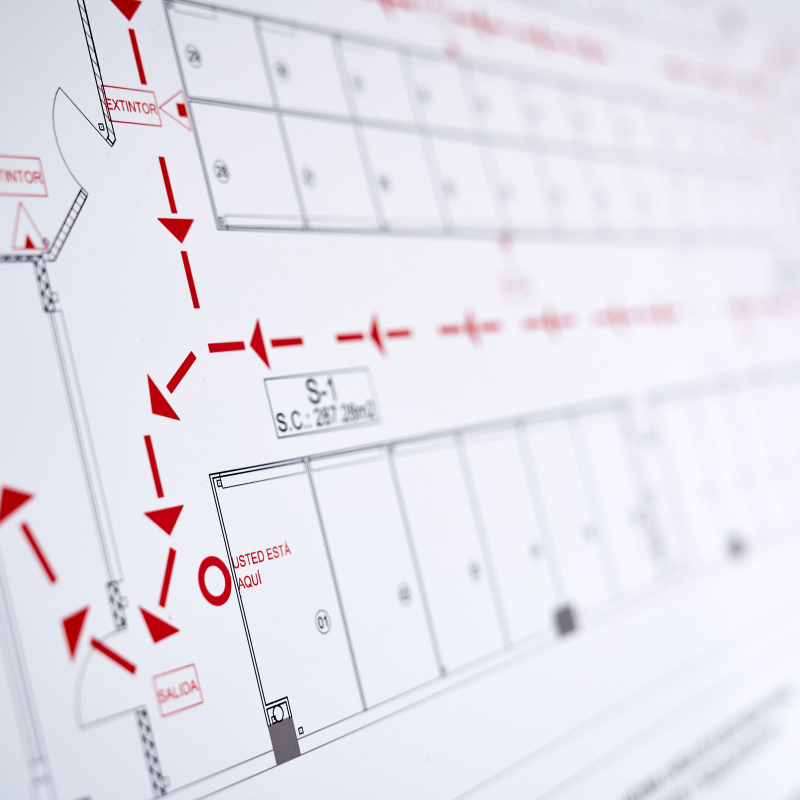Navigating through the vast corridors of buildings, whether they be sprawling corporate campuses, hospitals, or educational institutions, requires more than just intuition—it demands a well-thought-out wayfinding signage package. For building managers, facility managers, architects, and building owners, understanding the nuances of creating an effective wayfinding system is paramount. This article delves into the key ideas and tips essential for putting together a building wayfinding signage package that not only guides but enhances the user experience.
Understanding Wayfinding Signage
Wayfinding signage is more than just signs pointing directions; it’s a comprehensive system designed to guide people through a physical environment and enhance their understanding and experience of the space. The effectiveness of a wayfinding system lies in its ability to communicate information clearly and efficiently to various users, including visitors, staff, and individuals with disabilities.
The Four Types of Wayfinding Signage
- Identification Signage: These signs help users identify their current location within a space, such as room numbers, building names, and facility areas.
- Directional Signage: Essential for navigation, directional signs guide users from one location to another, highlighting paths and directions to key areas.
- Informational Signage: This type provides users with general information about the facility, such as maps, directories, and rules.
- Regulatory Signage: Necessary for safety and compliance, regulatory signs inform users of laws, regulations, and guidelines within the facility.
Key Considerations in Wayfinding Signage Design
Audience Understanding: Know the users of your facility. Designing effective wayfinding signage starts with understanding who will be using the space and what their specific needs are, including considerations for disabilities.
Consistency: Maintain consistency in design across all signage to avoid confusion. This includes consistent use of colors, fonts, symbols, and messaging throughout the facility.
Visibility: Signs should be placed at strategic locations and heights to ensure they are easily visible. Lighting also plays a crucial role in ensuring signs are readable under all conditions.
Simplicity: Keep messages clear and concise. Overloading signs with too much information can overwhelm users and complicate navigation.
Flexibility: Design your wayfinding system with the future in mind. Facilities evolve, and so should your signage. Ensure that updating information on signs is straightforward and cost-effective.
Step-by-Step Guide to Developing Your Wayfinding Signage Package
Conduct a Site Audit: Begin with a thorough evaluation of your facility. Identify potential navigation challenges, key destinations, decision points, and areas where signage is crucial.
2. Develop a Signage Strategy: Based on your audit, create a strategy that addresses the four types of wayfinding signage. Consider the user journey from multiple entry points and ensure that your system guides them efficiently to their destinations.
3. Design with the User in Mind: Design signs that are intuitive and easy to understand. Use symbols and pictograms where possible to transcend language barriers. Also, consider color-coding different areas or floors for easier recognition.
4. Ensure ADA Compliance: The Americans with Disabilities Act (ADA) sets standards for accessible design, including signage. Ensure your signs are accessible to all users, including those with visual impairments, by following ADA guidelines for font size, contrast, and braille inclusion.
5. Prototype and Test: Before full implementation, prototype key signs and place them in their intended locations. Gather feedback from a diverse group of users to make necessary adjustments.
6. Implement and Monitor: Once your wayfinding signage package is installed, continuously monitor its effectiveness. Observe how users interact with the system and make adjustments as needed.

Tips for Wayfinding Signage Success
- Engage a Professional: Consider working with a professional designer or a signage company specializing in wayfinding systems. Their expertise can be invaluable in creating an effective and compliant signage package.
- Use Technology: Incorporate digital signage and interactive kiosks as part of your wayfinding strategy. These can provide dynamic directions and information that can be easily updated.
- Consider the Environment: The design of your signs should complement the architectural and interior design of your facility. Signs should enhance, not detract from, the overall aesthetic.
- Train Your Staff: Ensure that your staff is familiar with the wayfinding system. They should be able to assist users and provide feedback on the system’s effectiveness.
- Plan for Maintenance: Regular maintenance is crucial to ensure that signs remain visible, legible, and accurate. Establish a maintenance plan that includes regular inspections and timely updates.
Some Final Thoughts
A well-designed wayfinding signage package is crucial for any facility. It enhances the user experience, ensures safety, and contributes to the overall functionality of the space. By understanding your audience, maintaining consistency, and designing with simplicity and flexibility in mind, you can create an effective wayfinding system that meets the needs of all users.
Remember, wayfinding is an ongoing process that evolves with your facility. Continuous evaluation and adaptation are key to maintaining an effective signage system. By following the steps and tips outlined in this guide, building managers, facility managers, architects, and building owners can ensure their facilities are welcoming, accessible, and easy to navigate.
USEFUL RESOURCE: For detailed information on wayfinding signage and accessibility guidelines, you can visit the United States Access Board’s official website at www.access-board.gov. The website provides access to the ADA Standards for Accessible Design, among other resources.
The creation of a successful wayfinding signage package is not just about directing people; it’s about creating an intuitive and inclusive environment that enhances the overall experience of your facility. With careful planning, design, and implementation, you can achieve a wayfinding system that reflects the values and needs of your organization and its users.

